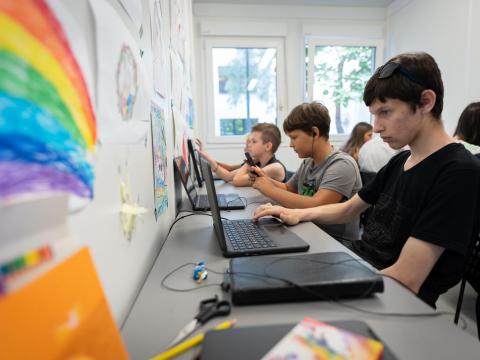Empowering Humanitarian Practitioners with AI: World Vision’s Participation in the Integrate Project

By Charbel Chidiac, Senior Technical Advisor for Education in Emergencies
On the 2025 International Day of Education, the spotlight falls on the transformative role of education in preparing communities for an era defined by technological advancements. Representing World Vision International (WVI), I am proud to be personally involved in the Integrate project, contributing to the development and implementation of an innovative solution that strengthens child protection and education in emergencies (EiE).
The Integrate initiative, developed collaboratively by the Inter-agency Network for Education in Emergencies (INEE), the Alliance for Child Protection in Humanitarian Action, and key partners such as WVI, harnesses the potential of AI to streamline and strengthen the integration of CPHA and EiE interventions. This pilot leverages an AI-powered tool designed to provide real-time support to humanitarian practitioners, something that could greatly expand existing services like the INEE and Alliance Help Desks, which are operated by INEE and Alliance staff and provides multilingual expert responses to queries on EiE and CPHA topics in assistance in Arabic, French, Spanish, Portuguese, and English. In addition, Integrate can enable EiE and CPHA experts who are providing technical support to others, to more quickly and thoroughly develop standard operating procedures (SOPs), concept notes, and step-by-step guides with precision and cultural sensitivity.
Bridging Complexity with Technology
In crisis settings, practitioners often face time constraints and overwhelming information, making it difficult to align protection and education responses. The Integrate tool addresses this by providing access to up-to-date guidelines, practical tips, and customizable templates for program planning. With features such as interactive checklists and training outlines, it not only simplifies the workflow but also ensures that interventions remain child-centered and compliant with global standards .
For instance, a frontline education specialist in a displacement camp can swiftly generate a contextualized EiE-CPHA integration plan, informed by INEE standards and tailored to local needs. This reduces delays in service delivery and mitigates the risks faced by vulnerable children, such as exploitation or prolonged learning disruptions.
Upholding Human Agency Amid Technological Innovation
While Integrate offers practical benefits, it emphasizes that AI-driven tools are complements, not replacements, for human expertise. As a WVI representative, I actively contribute to ensuring that the tool meets the needs of practitioners by participating in feedback loops, testing sessions, and collaborative design processes. Orientation sessions and technical support empower practitioners to critically engage with AI outputs, ensuring alignment with community realities and ethical standards.
To address concerns around biases and cultural sensitivity, Integrate continuously improves based on user feedback. By prioritizing transparency and collaboration with CPHA and EiE experts, the project mitigates risks related to misinformation, over-reliance, and incomplete guidance.
Toward a More Inclusive Humanitarian Future
By embedding AI within the humanitarian ecosystem, World Vision International and its partners illustrate how education can equip communities not only to respond to technological shifts but to shape them. As the Integrate project moves into its next phases, it aims to scale and refine its offerings, fostering a future where education in emergencies is even more responsive, inclusive, and resilient than it is today.
The 2025 International Day of Education urges reflection on how technology can elevate—not erode—human agency. Initiatives like Integrate exemplify this ethos, demonstrating that when used thoughtfully, technology can enhance the capacity of practitioners to create safer, more nurturing learning environments for children affected by crises.
Note: This article was written by Integrate with human guidance.